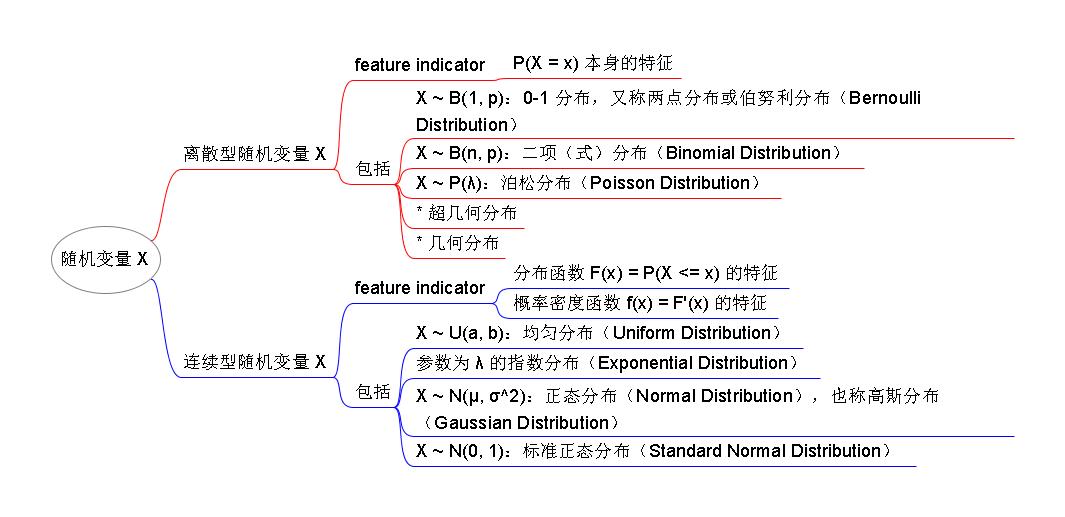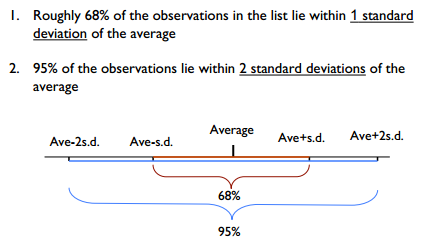R Generating Random Numbers and Random Sampling
感性复习:如何理解钟形曲线
$P(X = x)$ 表示随机变量 $X = x$ 的概率,$F(x) = P(X \leq x)$ 称为随机变量 $X$ 的 分布函数。若 $F(x)$ 可微,则 $f(x) = F’(x)$ 称为随机变量 $X$ 的 概率密度函数,简称为 概率密度。
$f(x)$ 的值具体是多少没有多大意义,但是 $f(x)$ 值的是大是小可以说明随机变量 $X$ 取值的密集程度,比如 $f(3) > f(2)$,说明 $X = 3$ 的样本数多于 $X = 2$ 的样本数。
$y = f(x)$ 是 概率密度曲线,$P(x_1 < X \leq x_2)$ 的值等于 “以 $(x_1, x_2]$ 为底,以 $y = f(x)$ 为顶的曲边梯形的面积”。钟形曲线只是一种特殊的概率密度曲线。
感性复习:分布来分布去
随机变量 $X$ 有两种大类型:
- 离散型随机变量 $X$
- 连续型随机变量 $X$
对于连续型随机变量 $X$,我们倒腾半天搞出 $F(x)$ 和 $f(x)$ 就是为了描述 $X$ 的特征。那么对于离散型随机变量 $X$ 的特征,我们更多是根据 $P(X = x)$ 这个函数本身的特征来描述。如果 $X$ 具有某些特定的特征,我们称 $X$ 满足某某分布。

新知识:分位数 Quantile [‘kwɒntaɪl]
对正态分布 $X \sim N(\mu, \sigma^2)$,若 $a < \mu$,有:
- 若 $F(x) = P(X \leq x) = a$,称 $x$ 为 下侧 $a$ 分位数(在 $y = f(x)$ 图中 $x = \mu$ 左侧)
- 若 $F(x) = P(X \leq x) = 1 - a$,i.e $P(X > x) = a$,称 $x$ 为 上侧 $a$ 分位数(在 $y = f(x)$ 图中 $x = \mu$ 右侧)
对一个确定的 $a$,它的分位数常写作 $ u_a $。比如 $X \sim N(0, 1)$ 中,上侧 $ u_{0.05} $ = 1.65,则表示 $P(X > 1.65) = 0.05$。所以你可以把分位数理解为 $X$ 的一种临界值。
正态分布的一些区间特性

图片来源:Lecture 2: Descriptive Statistics and Exploratory Data Analysis
其实还有,根据 quartile 这一节 IQR 的定义,50% of the observations 是在 [Ave - 0.5*IQR, Ave + 0.5*IQR] 这个区间内的。
正态分布相关函数
- rnorm: generate random Normal variates with a given mean and standard deviation [ˌdi:viˈeɪʃn]
rnorm(n, mean = 0, sd = 1)即生成 n 个符合正态分布的随机值- mean 指 均值,i.e. 期望值,即 $X \sim N(\mu, \sigma^2)$ 中的 $\mu$;默认为 0
- standard deviation 指 标准差,即 $X \sim N(\mu, \sigma^2)$ 中的 $\sigma$;默认为 1
- $\sigma^2$ 是 方差 variance [ˈvɛriəns]
- dnorm: evaluate the Normal probability density (with a given mean/SD) at a point (or vector of points)
dnorm(x, mean = 0, sd = 1, log = FALSE)计算 $x$ 在这个N(mean, sd^2)分布上的概率密度,即 $f(x)$- if
log = TRUE, probabilities $p$ are given as $\log p$
- pnorm: evaluate the cumulative distribution function for a Normal distribution
pnorm(q, mean = 0, sd = 1, lower.tail = TRUE, log.p = FALSE)计算 q 在这个N(mean, sd^2)分布上的分布函数值,即 $F(q)$- cumulative distribution 是 累积分布函数,其实就是 F(x),不知为何我的教材只翻译成分布函数
- if
log.p = TRUE, probabilities $p$ are given as $\log p$ - if
lower.tail = TRUE (default), probabilities are $P[X \leq x]$ otherwise, $P[X > x]$.
- qnorm: gives the quantile
qnorm(p, mean = 0, sd = 1, lower.tail = TRUE, log.p = FALSE)给出 $a = p$ 在这个N(mean, sd^2)分布上的分位数- 默认是给出下侧分位数
- if
lower.tail = FALSE,给出上侧分位数 - 比如
qnorm(0.05) = -1.644854,qnorm(0.05, lower.tail=F) = 1.644854
泊松分布相关函数
- rpois: generate random Poisson variates with a given rate
rpois(n, lambda)生成 n 个满足P(lambda)泊松分布的随机数
- 同理有 dpois、ppois、qpois
二项分布相关函数
- rbinom: generate random Binomial variates with a given number of trials and the probability of success on each trial
rbinom(n, size, prob)生成 n 个满足B(size, prob)二次分布的随机数
- 同理有 dbinom、pbinom、qbinom
r、d、p、q 一般规律
- r for random number generation
- d for density, i.e. $f(x)$
- p for cumulative distribution, i.e. $F(x)$
- q for quantile function, i.e. $ u_a $
set.seed(n)
Setting the random number seed with set.seed() ensures reproducibility.
< set.seed(1)
< rnorm(5)
[1] -0.6264538 0.1836433 -0.8356286 1.5952808
[5] 0.3295078
< rnorm(5)
[1] -0.8204684 0.4874291 0.7383247 0.5757814
[5] -0.3053884
< set.seed(1)
< rnorm(5)
[1] -0.6264538 0.1836433 -0.8356286 1.5952808
[5] 0.3295078
set the random number seed when conducting a simulation!
an example of simulating linear model
假设 $Y = aX + E$,$X \sim N(0,1)$, $E \sim (0,2^2)$, $a = 2$,我们模拟这个曲线可以用:
> set.seed(20)
> x <- rnorm(100)
> e <- rnorm(100, 0, 2)
> y <- 2x + e
> summary(y)
Min. 1st Qu. Median
-6.4080 -1.5400 0.6789 0.6893 2.9300 6.5050
> plot(x, y)
Random Sampling
The sample() function draws randomly from a specified set of (scalar) objects allowing you to sample from arbitrary distributions.
> set.seed(1)
> sample(1:10, 4)
[1] 3 4 5 7
> sample(1:10, 4)
[1] 3 9 8 5
> sample(letters, 5)
[1] "q" "b" "e" "x" "p"
> sample(1:10) ## Generate Permutation(序列)
[1] 4 710 6 9 2 8 3 1 5
> sample(1:10)
[1] 2 3 4 1 9 5 10 8 6 7
> sample(1:10, replace = TRUE) ## Sample w/ replacement
[1] 2 9 7 8 2 8 5 9 7 8
留下评论